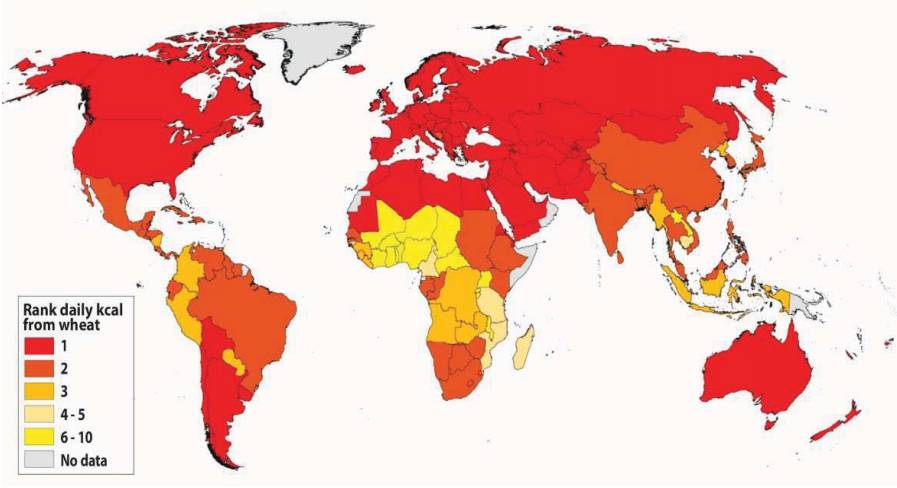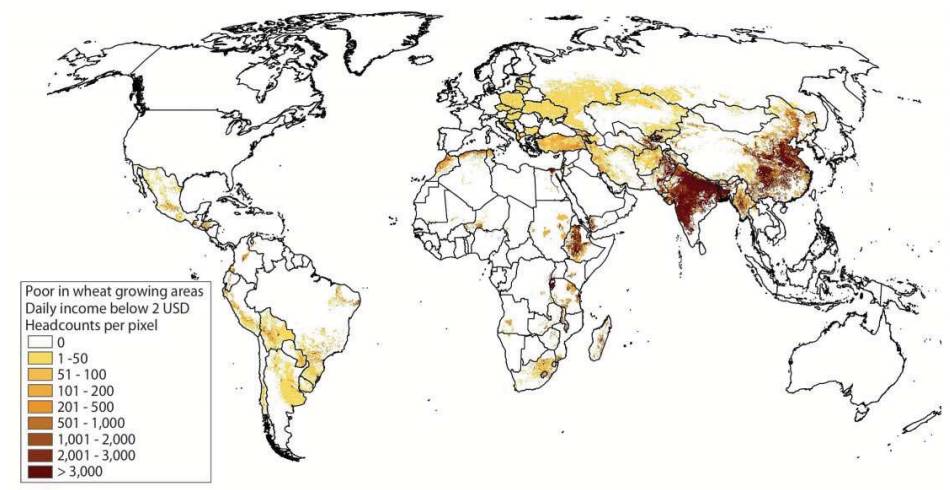"Nobody is qualified to become a statesman who is entirely ignorant of the problem of wheat.” [Socrates]
- Wheat is grown on more land area than any other crop (220 million hectares). [FAOSTAT 2013]
- Wheat was one of the first domesticated food crops and for 8000 years has been the basic staple food of major civilizations in Europe, West Asia, and North Africa.
- There are more varieties of wheat than any other cereal crops - about 5,000 cultivars of bread wheat in current use (about 35,000 cultivars have been developed throughout history, but the vast majority of these are no longer cultivated on a commercial scale). [Kew 2013]
- Wheat is cultivated in every continent except Antarctica. It is grown at a wide elevational range from 260 m below sea level (Jordan Valley) up to 4,000 m (Tibetan plateau). [Kew 2013]
- Because wheat is such a versatile crop, it is being harvested somewhere in the world every month of the year. [OkState]
- World trade for wheat is greater than for any other cereal. [FAOSTAT 2013] The only other agricultural commodity traded more than wheat are soybeans and soybean products. [USDA]
- More foods are made with wheat than any other cereal grain. [Wheat Foods Council]
- Wheat provides more nourishment (calories & proteins) for humans than any other single food crop. [FAOSTAT 2013]
- Accounting for a fifth of humanity's food, wheat is a second only to rice as a source of calories in the diets of developing country consumers, and it is first as a source of protein [Braun et al. 2010] - Figure 1
- An estimated 1.2 billion poor people depend on wheat, a crop that is particularly vulnerable to climate change. In South Asia, wheat yields are projected to decline 20-30 percent by 2050. [Feed The Future]
- Wheat is an especially critical “staff of life” for the approximately 1.2 billion “wheat dependent” to 2.5 billion “wheat consuming” poor— men, women and children who live on less than USD 2 per day— and approximately 30 million poor wheat producers and their families. [Wheat CRP] - Figure 2
- Demand for wheat in the developing world is projected to increase 60% by 2050. At the same time, climate-change-induced temperature increases are likely to reduce wheat production in developing countries by 20–30%. [Wheat CRP]
Top 10 wheat producing countries in 2013 [FAOSTAT 2014]:
- China (121,7 Mt)
- India (93,5 Mt)
- United States (58.0 Mt)
- Russia (52,1 Mt)
- France (38,6 Mt)
- Canada (37.5 Mt)
- Germany (25,0 Mt)
- Pakistan (24,2 Mt)
- Australia (22,8 Mt)
- Ukraine (22,8 Mt)
Figure 1 - Relative rank of wheat as a food crop worldwide [Wheat CRP document]

Figure 2 - The poor in wheat growing areas who live on US$ 2 or less per day (1 pixel = 100 sq.km) [Wheat CRP document]

References:
- Braun, H.J., Atlin, G. and Payne, T. 2010. Multilocation testing as a tool to identify plant response to global climate change. In: Reynolds, M. (Ed.). Climate Change and Crop Production, CABI, London, UK.